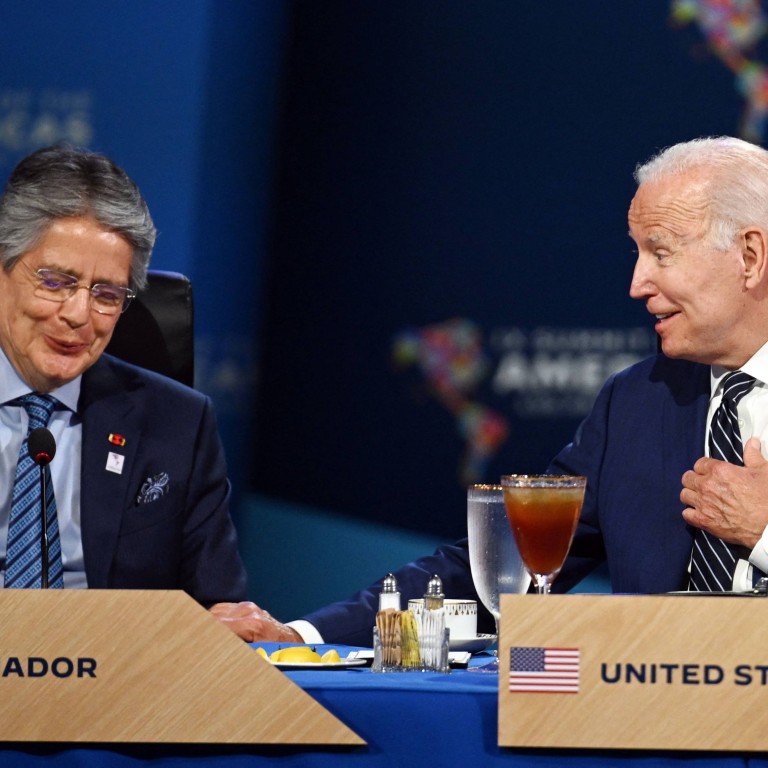
US frets about ‘erosion of influence’ as China and Ecuador move closer to a free-trade deal
- A free-trade deal with Ecuador would be China’s fourth with a Latin American country, after signing agreements with Chile, Costa Rica and Peru
- The warming relations have fuelled calls in the United States to open trade talks with Ecuador to counter China’s growing influence in the region
As Ecuador and China move closer towards sealing a free-trade agreement, concern is mounting in Washington that the United States is losing influence in Latin America.
Ecuadorean President Guillermo Lasso said early in December that negotiations with China on a bilateral free-trade deal (FTA) were “practically closed”, some 10 months after talks started. The deal is expected to boost the value of Ecuadorean exports to China to US$1 billion, while offering Chinese firms access to an array of raw materials.
China’s 5 Latin America trade deals offer ‘new factor’, undercut US influence
“Without further US engagement,” wrote senators Bob Menendez and Rob Portman last week, “the United States risks losing market opportunities for American companies and the potential erosion of our influence in the region relative to China.”
China surpassed the US as Ecuador’s biggest export destination for non-oil products in the first seven months of the year, with shrimp and copper concentrate the leading export products.
Ecuador’s exports to China exceeded US$6.2 billion between January and November, with the South American nation recording a trade surplus for the first time. China’s exports stood at US$5.8 billion over the same period, according to Chinese customs data.
Ecuador’s overall exports to China increased by about 30 per cent compared to the same period last year.
Exports of exotic and tropical fruits such as dragonfruit and pitaya will increase under a FTA, said Felipe Ribadeneira Molestina, president of the Ecuadorean Federation of Exporters.
Gustavo Cáceres Pazmiño, executive director of the Ecuadorean China Chamber of Commerce, said the deal would level the playing field with competitors in the Association of Southeast Asian Nations (Asean) when it came to accessing the Chinese market.
“[Asean countries] are nearer to China and some of them have tariff benefits that we don’t. With the FTA we will have an opportunity to compete with them better,” he said.
For China, Latin America offers an opportunity to diversify sources of strategic minerals that it needs to fuel its economy, especially as relations with the West deteriorate.
Ecuador is of significant interest because of its extractable reserves of copper, iron ore and oil.
China in Latin America: partner or predator?
Steady Chinese investment in the mining sector and for other infrastructure projects has been vital for Ecuador, which has struggled to gain international financing after the drop in oil prices in recent years, according to the Washington DC-based Carnegie Endowment for International Peace.
“The mining sector in Ecuador is beginning to grow,” said Molestina. “It is going to be really attractive for Chinese companies to invest in after the agreement.”
Two of Ecuador’s largest copper mines, the San Carlos-Panantza and Mirador, are owned by the Chinese state-owned enterprise CRCC-Tongguan.
The US announced a Fair Trade Working Group with Ecuador on November 1, which will convene talks on digital trade, labour and environmental issues.
Robert Evan Ellis, Latin American Studies professor at the US Army War College Strategic Studies Institute, said the Biden administration is not looking to compete dollar for dollar with China in the region.
Instead, the US has extended cooperation on security and migration issues.
Ecuador’s Lasso met with US President Joe Biden last week at the White House and discussed security issues, migration and sustainability, while discussion of trade was minimal.
According to Ellis, Ecuador is a good example of the US partnering with a country to mitigate some of the problems associated with working with China, “whether environmental, or risks associated with project completion”.
The US, for example, has helped Ecuador deal with engineering defects in the China-built Coca Codo Sinclair hydroelectric power plant and regressive erosion of the Coca river by sending specialist engineers, Ellis said.
“One of the challenges for large Chinese companies is to partner with local firms and to give appropriate consideration to due diligence and community consultations,” he said. “But Chinese companies are getting better at these issues.”
How is China rebuilding supply chains abroad after 3 years of isolation?
Since taking office, Lasso has pursued “a healthy strategy of diversification” by strengthening relations with China and the US, with the trade deal being part of it, said Ellis.
While a FTA will remove barriers for Ecuadorean businesses, there is a “limited upside” for exports of traditional foodstuffs, said Ellis, due to “the cost disadvantage of sending refrigerated containers halfway around the world”.
“Many of those undifferentiated products can be bought from closer places like Vietnam or Thailand,” he said.
Certain industrial sectors such as footwear and textile have asked to be excluded from the FTA, according to Molestina, due to the competition they will face from Chinese products.
“We understand that China has acknowledged that certain sectors need to be excluded in its past agreements with Latin American nations,” said Molestina, adding that even if Chinese companies have to pay tariffs to enter the Ecuadorean market, they would still be “in a good position to compete”.



